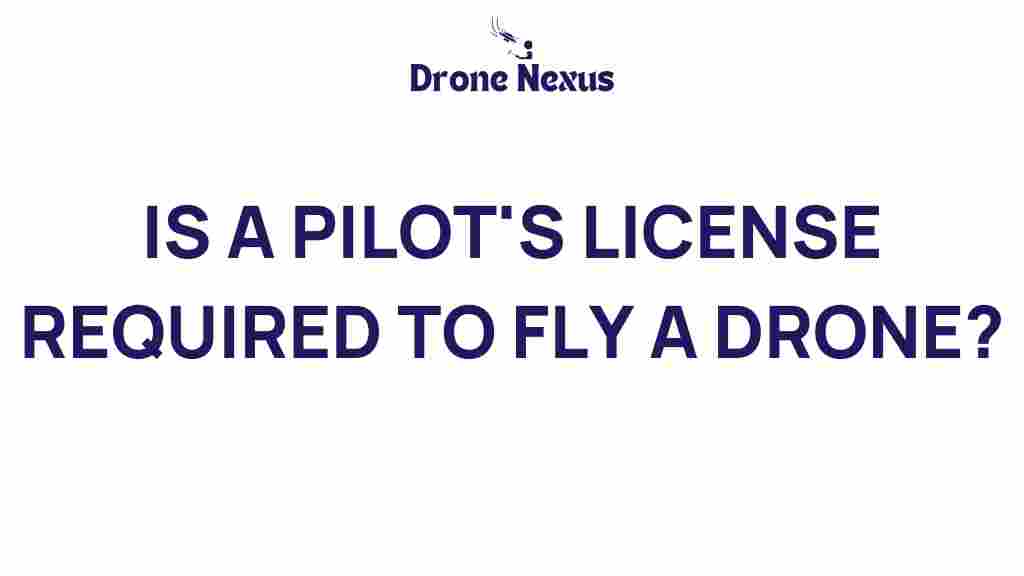Is a Pilot’s License Required to Fly a Drone?
In recent years, the popularity of drones has skyrocketed, leading to a surge in recreational and commercial use. However, many aspiring drone pilots find themselves asking, “Is a pilot’s license required to fly a drone?” This question is often shrouded in myths and misconceptions. In this article, we aim to unravel these myths and provide clear guidance on the requirements for flying drones. With the right knowledge, you can navigate the regulations and enjoy the exciting world of drone flying!
Understanding Drone Regulations
Before diving into whether a pilot’s license is necessary, it’s crucial to understand the regulations governing drone usage. In the United States, the Federal Aviation Administration (FAA) oversees drone operations. The FAA categorizes drone pilots into two groups: recreational users and commercial operators.
Recreational Drone Pilots
For those flying drones purely for enjoyment, the FAA has established specific guidelines. Notably, a pilot’s license is not required for recreational drone flying. However, recreational pilots must adhere to the following rules:
- Fly the drone below 400 feet.
- Keep the drone within visual line-of-sight.
- Fly only for recreational purposes.
- Register the drone if it weighs over 0.55 pounds.
- Follow community-based guidelines.
By following these guidelines, recreational drone pilots can enjoy their flying experience without needing a pilot’s license.
Commercial Drone Pilots
For those looking to use drones for commercial purposes, the regulations become more stringent. Commercial drone pilots must obtain a Remote Pilot Certificate from the FAA, which requires passing a knowledge test. Here are the steps to obtain this certification:
- Study the Remote Pilot Knowledge Test: Familiarize yourself with the FAA regulations, airspace classification, weather, and drone operations.
- Schedule the Exam: Register for the FAA’s Remote Pilot Knowledge Test at an approved testing center.
- Pass the Test: Successfully complete the knowledge test to demonstrate your understanding of the necessary regulations.
- Submit an Application: Complete the FAA’s application process to receive your Remote Pilot Certificate.
Once you obtain the Remote Pilot Certificate, you can legally operate drones for commercial purposes, such as aerial photography, surveying, or inspections. While a traditional pilot’s license is not required, the Remote Pilot Certificate serves a similar purpose for drone operations.
Common Myths About Drone Flying
As drone enthusiasts navigate the legal landscape, several myths can create confusion. Let’s debunk some of the most common misconceptions:
- Myth 1: You need a pilot’s license to fly any type of drone.
Fact: A pilot’s license is not required for recreational flying, but commercial pilots must obtain a Remote Pilot Certificate. - Myth 2: All drones require FAA registration.
Fact: Only drones weighing over 0.55 pounds must be registered with the FAA. - Myth 3: Drones can be flown anywhere.
Fact: Drones must be flown in accordance with local laws and regulations, avoiding restricted airspace.
Step-by-Step Guide to Flying Drones Legally
To help you navigate the process of flying drones legally, here’s a step-by-step guide:
1. Determine Your Purpose for Flying
Decide whether you will be flying for recreational or commercial reasons. This will dictate the necessary steps and certifications required.
2. Check Local Regulations
Research local laws and regulations regarding drone use. Some areas may have additional restrictions or requirements.
3. Register Your Drone (if necessary)
If your drone weighs more than 0.55 pounds, you must register it with the FAA. Registration can be done online and is valid for three years.
4. Obtain Required Certifications
If you plan to fly commercially, study for and pass the FAA’s Remote Pilot Knowledge Test to obtain your Remote Pilot Certificate.
5. Follow Safety Guidelines
Always adhere to safety guidelines, including:
- Flying below 400 feet.
- Maintaining visual line-of-sight.
- Avoiding flying near airports or restricted airspace.
6. Stay Informed
Keep up-to-date with any changes in regulations or guidelines from the FAA or local authorities to ensure compliance.
Troubleshooting Common Issues
Even experienced drone pilots can face challenges. Here are some common issues and troubleshooting tips:
1. Drone Won’t Connect to Remote
If your drone isn’t connecting to the remote control, try the following:
- Check the battery levels of both the drone and the remote.
- Restart both devices.
- Ensure that you are within the appropriate range for connection.
2. Poor Video Quality
If you notice a decline in video quality, consider these solutions:
- Check the camera lens for dirt or obstructions.
- Make sure you are flying in optimal weather conditions.
- Update the firmware of your drone to ensure the best performance.
3. Loss of GPS Signal
If you lose GPS signal during flight, follow these steps:
- Return the drone to a location with a clearer view of the sky.
- Wait for a few moments for the GPS to reconnect.
- Always maintain visual line-of-sight to your drone.
Conclusion
In conclusion, while a traditional pilot’s license is not required to fly a drone, understanding the necessary regulations is crucial for both recreational and commercial operators. Recreational pilots can enjoy flying without a pilot’s license, provided they follow the FAA’s guidelines. However, commercial pilots must obtain a Remote Pilot Certificate to operate legally.
By debunking myths and understanding the requirements, you can confidently take to the skies. Whether you are a hobbyist or a professional, knowing the rules will help you enjoy the thrilling world of drone flying while ensuring safety and compliance. For further guidance on drone regulations, visit the FAA’s official UAS webpage. Happy flying!
For more tips on drone operation and safety, check out our comprehensive guide.
This article is in the category Safety and created by DroneNexus Team
